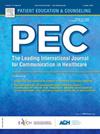在生物心理社会模型中解释头痛的实践建议
IF 2.9
2区 医学
Q2 PUBLIC, ENVIRONMENTAL & OCCUPATIONAL HEALTH
引用次数: 0
摘要
目的本研究旨在确定非轻蔑的语言和综合实践建议,供医疗提供者在讨论慢性疼痛的潜在心理病因时使用。方法:社区招募新生成人(18- 25岁;N = 138;68 %女性)参与了目前的研究,作为一个更大的在线调查的一部分。参与者被随机分配阅读“不屑一顾”(即,将疼痛主要归因于心理病因)或“生物心理社会”(即,提供更细致的解释疼痛的心理和生理病因之间复杂的相互作用)小短文,描述关于慢性每日头痛主诉的假想患者-提供者互动。结果阅读生物心理社会小插图的参与者和男性参与者报告了更多的积极反应(例如,更多的满意度,更高的继续护理的可能性)。定性结果显示,读了轻蔑小插图的参与者更有可能觉得自己的时间被浪费了,有义务进一步解释自己的痛苦。结论:在生物-心理-社会框架下,对慢性日常头痛的心理病因的假设提供者解释更能得到积极的接受。实践意义本文提出了医疗服务提供者应如何以非轻视的方式介绍患者头痛经验的潜在心理病因,以减少提供者产生的疼痛忽视经验的可能性的实践建议。本文章由计算机程序翻译,如有差异,请以英文原文为准。
Practice recommendations for contextualizing explanations of headache pain within a biopsychosocial model
Objective
The current study aimed to identify non-dismissive language and synthesize practice recommendations for medical providers to use when discussing potential psychological etiologies of chronic pain.
Methods
Community-recruited emerging adults (18- to 25-year-olds; N = 138; 68 % female) participated in the current study as part of a larger online survey. Participants were randomly assigned to read either a “dismissive” (i.e., attributed pain to primarily psychological etiologies) or “biopsychosocial” (i.e., provided a more nuanced explanation of the complex interplay between psychological and physiological etiologies of pain) vignette describing hypothetical patient-provider interactions regarding -chronic daily headache complaints.
Results
Participants who read the biopsychosocial vignette and male participants reported significantly more positive reactions (e.g., more satisfaction, higher likelihood of continued care). Qualitative results showed that participants who read the dismissive vignette were more likely to feel their time had been wasted and obligated to explain their pain further.
Conclusions
Hypothetical provider explanations of psychological etiologies of chronic daily headache pain were received more positively when contextualized within a biopsychosocial framework.
Practice implications
This article presents practice recommendations for how medical providers should introduce potential psychological etiologies of a patient’s headache pain experience in a non-dismissive manner to decrease the likelihood of provider-generated pain dismissal experiences.
求助全文
通过发布文献求助,成功后即可免费获取论文全文。
去求助
来源期刊

Patient Education and Counseling
医学-公共卫生、环境卫生与职业卫生
CiteScore
5.60
自引率
11.40%
发文量
384
审稿时长
46 days
期刊介绍:
Patient Education and Counseling is an interdisciplinary, international journal for patient education and health promotion researchers, managers and clinicians. The journal seeks to explore and elucidate the educational, counseling and communication models in health care. Its aim is to provide a forum for fundamental as well as applied research, and to promote the study of organizational issues involved with the delivery of patient education, counseling, health promotion services and training models in improving communication between providers and patients.
 求助内容:
求助内容: 应助结果提醒方式:
应助结果提醒方式:


